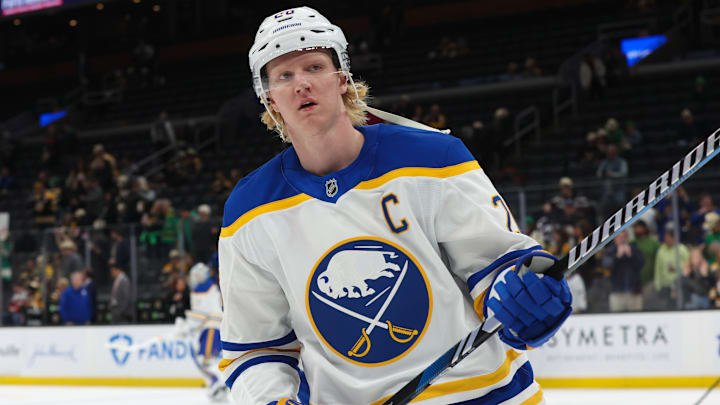The Buffalo Sabres are entrenched in a 14-year playoff drought but fans desperately seeking a dose of optimism can look toward the recently released Daily Faceoff projected ranking for the top 30 NHL players in the year 2030.
Daily Faceoff's Paul Pidutti, who's known for his efforts to adjust hockey stats depending on a player's era and then using that information to determine the strength of their Hall of Fame case, released the top 30 list on Wednesday. Two Sabres made the cut: Rasmus Dahlin and Owen Power.
Although Dahlin was a slam-dunk selection, checking in at No. 12 overall, it was a bit surprising to see Power crack the rankings at No. 30.
Dahlin rated as NHL's fourth-best defenseman in 2030
The Sabres captain could have easily made the top 10 on the 2030 outlook. It's hard to argue against the placement of the Colorado Avalanche's Cale Makar (No. 2) or Vancouver Canucks' Quinn Hughes (No. 4), but placing the Ottawa Senators' Jake Sanderson at No. 10 instead of Dahlin is questionable.
Make no mistake, Sanderson's career is off to a terrific start, including 57 points in 80 appearances for the Sens last season. Dahlin posted 68 points in 2024-25, however, and is producing at that elite rate despite having less talent around him in Buffalo.
The latter point is far too often overlooked. There's a real chance 25-year-old Swede would be viewed as the NHL's best defenseman if he played for a perennial contender. Being stuck on a yearly also-ran has limited his national exposure.
Alas, the flip side of that coin is worrisome for Sabres fans: How long will Dahlin wait for Buffalo's front office to turn things around before he considers joining the likes of Sam Reinhart, Jack Eichel and Ryan O'Reilly, who all enjoyed their best hockey lives after leaving the organization.
Dahlin will be one of the NHL's best players in 2030, regardless of where he's playing.
Power must elevate his game to match list's expectations
Power is a difficult evaluation because there are so many variables. His size (6'6'', 226 pounds) and pedigree (first overall pick in 2021) created sky-high expectations, and there have been moments when he's looked like a potential franchise cornerstone.
On the plus side, he's coming off a career-high 40 points (seven goals and 33 assists) in 79 games for the Sabres last season. He's also proven himself as a impressive puck mover and his power-play upside has flashed despite the team's pitiful approach with the man advantage in recent years.
That said, Power has struggled mightily in his own zone at times. He doesn't throw his weight around often with hits and he often gets out-leveraged in front of the net despite his 6-foot-6 frame. It's made him an easy target for fans despite his impact offensively.
Then there's the playing partner issue. General manager Kevyn Adams has failed in multiple attempts to find the University of Michigan product a reliable defenseman to play next to him. Michael Kesselring, who was acquired from the Utah Mammoth in the JJ Peterka trade, could solve that issue.
Power still has a lot of untapped potential at age 22 and there's legitimate reason to believe he can made serious strides over the next five years. Yet, while it's possible he does solidify himself as a top-30 player in the seasons ahead, he's got a lot of work to do before reaching that elite threshold.
